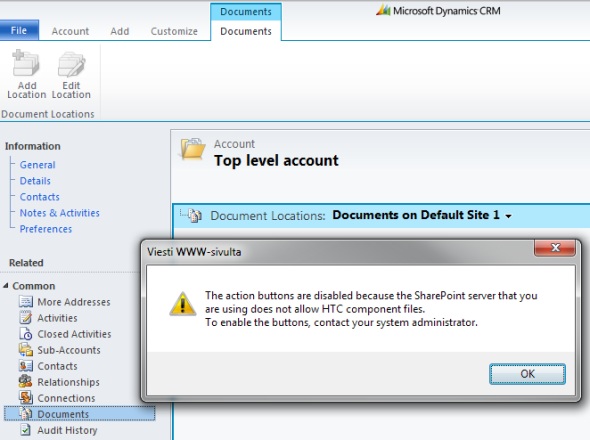Related sites:
Newsletter: Perspectives on Power Platform
Company: Niiranen Advisory Oy

Today was finally the big day when Microsoft’s cloud productivity platform BPOS was replaced with Office 365, which is now available for subscription. Having played with the beta version for a while now, I’m overall quite impressed with how close the SharePoint Online environment now is to its on-premises counterpart. While the limitations are still somewhat more visible than when comparing CRM Online vs. CRM 2011 on-premises versions, I think it’s already close enough to enable a significant part of traditional business requirements for SharePoint to be fulfilled with the cloud platform.
Microsoft confirmed already last fall that also Dynamics CRM Online will eventually be migrated onto the same Online Services Delivery Platform as Office 365. In addition to being a natural fit with SharePoint and Exchange, CRM Online should also gain benefits into both its subscription management as well as authentication options as a result of this migration. However, there’s no official timeline or feature set communicated yet, so we’ll have to keep waiting possibly until Q4/2011, when the next update for Dynamics CRM has been scheduled to become available, as announced in the latest Statement of Direction document.
Ever since Dynamics CRM 2011 was launched with built-in SharePoint document library integration, there’s been a bit of anxiety on when this functionality could be leveraged with the cloud versions of CRM and SharePoint. Since BPOS was built on SharePoint 2007, it wasn’t possible to utilize the Microsoft Dynamics CRM 2011 List Component for Microsoft SharePoint Server 2010 in the Online environment. This meant that setting up a document management enabled trial environment with CRM Online required an on-premises SharePoint server, which wasn’t too convenient. Nor was it for any customer looking to go “all in” with their MS applications. Oh well, but now that Office 365 is available, that’s all a thing of the past, isn’t it?
Wrong! Despite of the better together marketing message surrounding Office 365 and CRM Online, there’s actually still no way to integrate the SharePoint document libraries with the CRM List Component. Sure, you can upload the solution file into a SharePoint Online site and publish it. What you cannot do in the Online version is to take care of the second part of the installation steps, which involves the AllowHtcExtn.ps1 PowerShell script,used for enabling .htc file extensions to be served from SharePoint.
Why is this important? Because without the .htc support, you can’t actually do anything with the document library. The folder creation can be configured and it flows through as it should when accessing the Documents menu for a new record, such as an account. However, after that you are presented with the following prompt:

“The action buttons are disabled because the SharePoint server that you are using does not allow HTC component files. To enable the buttons, contact your system administrator.” What this means is that the document library will be rendered nicely inside the CRM entity form, but you can’t upload any documents to it. Clicking on the buttons does nothing, as they’re all disabled.

How about on the SharePoint side of things then? We can see that the entity specific document libraries are created and also the corresponding folders for each record where the document location has been defined. We can also of course use the native SharePoint UI to upload documents into the library.

Then when you access the corresponding record through CRM, you can see that the document does appear in the library. But with all the controls disabled, you again cannot do anything with it, like open the document, for example. How nice…

How did we end up in this situation where the latest and greatest cloud offerings from Microsoft are not working together like they obviously were inteded to? That’s a very good question. The problem with Office 365 SharePoint Online limitations and their implications to Dynamics CRM document management functionality has been a known issue throughout the whole beta phase of Office 365. There are several threads on the Office 365 community forums regarding this. Yet the response from Microsoft has been that this cannot be resolved by GA (general availability) of Office 365 (as in “today”), but rather we’ll have to wait for the first service update, probably. Come on! How can 6 months not be enough to allow one .htc file to perform its work and provide the document integration between CRM and SharePoint? I find it extremely strange that the product management behind Office 365 has allowed such a flaw to be included in the initial release version.
Of course eventually this issue will be solved and we’ll be able to experience the full document management process flow with Microsoft’s cloud applications.
Hi
Mary Jo Foley is saying that a more unified Office 365/MSCRM offering will be out before the end of 2011. Now I take that with a pinch of salt but lets hope our collective pressure can get a definitive roadmap out of Microsoft and that the 2 teams are locked in a room together till they sort it out!
http://www.zdnet.com/blog/microsoft/whats-next-for-office-365-crm-online-and-windows-intune/9848
Charlie
Oh dear – the lack of information or timescales are not very helpful.
I found a connect item people might want to vote on here:
https://connect.microsoft.com/dynamicssuggestions/feedback/details/669052/office-365-sharepoint-integration
I think it’s high time that we moved away from HTC files into a more standards compliant scripting model in any case. This will be a big boon for many companies looking to adopt CRM and utilise non-MS browsers. Regardless of how good IE gets, it should be obvious that cross platform compatibility is always going to be a good thing in the current technology landscape.
Not only would dropping HTC files enable this SharePoint integration to function, it would sell more licenses for CRM.
[…] Released Office 365 last week and one interesting thing I noticed this blog entry which explains that SharePoint and CRM 2011 are not compatible. This is an important […]
Here we are 6 months later, Q4 service updates are installed, and HTC is still not allowed in sharepoint online.
I’d say MS will not be doing this anytime soon. Anyone care to take it upon themselves to modify the scripts?
Re-disapointed,
Josh
This will actually be an update to SharePoint Online rather than CRM Online. From what I’ve heard the Office 365 updates are still in the process of being rolled out, so let’s give Microsoft a few more days to complete this wave.
[…] Previous problem is described and documented very well by Jukka Niiranen here: Office 365 launches without Dynamics CRM integration […]
Can the on-premise version of the CRM 2011 for Outllook client be installed into Outlook Office 365?
I’m 99% sure this is supported. As far as I know, the only real difference of the Office client applications in Office 365 is the license management, which is tied to the subscription period instead of your traditional product key.